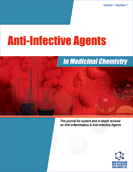Abstract
This review describes the novel experimental observations on antimicrobial and antiviral activities of a synthetic killer peptide (KP), derived from the variable region of a recombinant antiidiotypic antibody mimicking a widespectrum microbicidal yeast killer toxin (KT). The rationale, generation and experimental use of KT-like antiidiotypic microbicidal antibodies and mimotopes against the opportunistic pathogen Candida albicans were previously discussed. Recently, KP has demonstrated an in vitro microbicidal activity against such diverse AIDS-related pathogens as Cryptococcus neoformans, Pneumocystis carinii, Paracoccidioides brasiliensis, Acanthamoeba castellanii, Leishmania major and L. infantum, Mycobacterium tuberculosis and other bacteria. KP also demonstrated a significant therapeutic effect against experimental vaginal and systemic candidiasis, disseminated cryptococcosis, and paracoccidioidomycosis. The observation that KP may inhibit ex-vivo HIV-1 replication, opens new perspectives in the simultaneous treatment of HIV-1 and AIDS-related opportunistic pathogens. Despite the advent of highly active antiretroviral therapy (HAART) has dramatically improved the prognosis and quality of life of HIV-infected people, opportunistic infections still remain the most common cause of death. Current combination regimens, moreover, remain hampered by issues of patient compliance, tolerance, long term toxicity, incomplete viral suppression, and drug resistance, which are often responsible for therapy failure. There is an urgent need for new therapeutic strategies in AIDS. The potential use of KP, endowed with minimal toxicity, ease of production and manipulation (such as its production in planta), differential antimicrobial and antiviral mechanism of action, and modulation of immune cell populations are discussed.
Keywords: Yeast killer toxin, killer mimotopes, antimicrobial therapy, antiidiotypic antibodies, anti-HIV therapy, opportunistic infections
 6
6





















